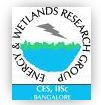 |
Land surface temperature with land cover dynamics: multi-resolution, spatio-temporal data analysis of Greater Bangalore |
 |
Conclusion This study analysed the role of increased urbanisation through spatial change analysis on LST, which is positively correlated with urbanising landscapes and negatively correlated with vegetation and water bodies. Abundance maps with pixels having 80-100% dense builtup and mixed builtup class proportions show increase in urban temperature by an average of 2 °C. LST were comparatively lower in areas having parks, healthy vegetation and lakes that aid as heat sinks. Although the algorithms adopted here seems to work satisfactorily, the classification and change detection methods in use were not very suitable for handling multi-sensor, multi-resolution condition as the classification accuracies obtained from MODIS data were low. These require advanced image fusion and LU classification algorithms or machine learning techniques to be adopted to achieve higher classification accuracies. The unmixing decision based approach adopted in this paper is an attempt to achieve classification results with higher accuracies per class. This could be automated to obtain LU classes and bring out changes across multi-temporal data routinely. Methods of change detection from multi-resolution images integrating spectral, structural and textural features to generate changed patches and change attribute is also desirable and a challenging area of research.
|